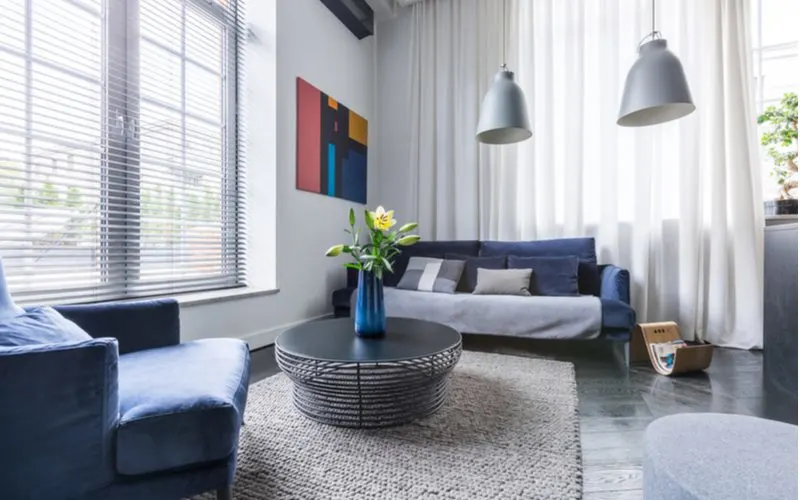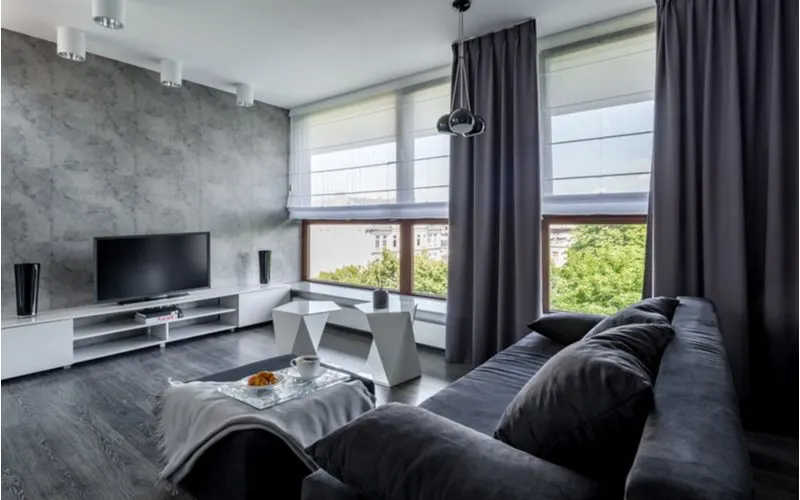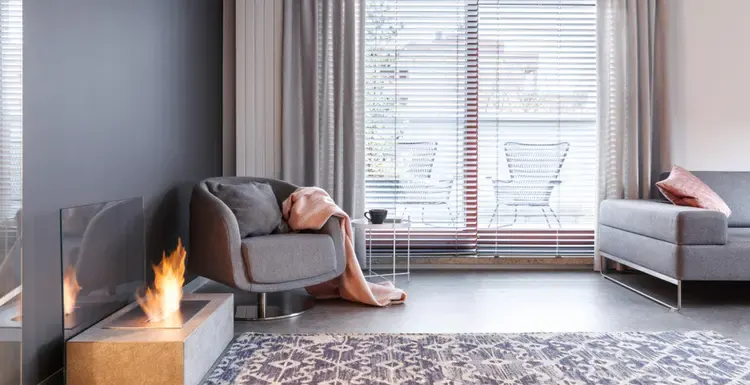Does it matter if you choose living room blinds or curtains?
Depending on your needs and the desired style of your living room, the choice between blinds or curtains can significantly impact the outcome.
We’ll show you why.
Considering Living Room Blinds or Curtains?
In general, blinds and curtains each have different pros and cons for use in your living room.
Choosing between the two options is a pretty big decision that you’ll have to base on your budget, cleaning habits, desired style, and preferences for letting in light.
So you’ll want to have all the facts before committing to either blinds or curtains.
Choosing Between Living Room Blinds or Curtains

Sergey Ryzhov/Shutterstock
Choosing between living room blinds and curtains might be one of the last decisions you make when moving into a new place or redesigning your living room.
However, it can impact how you use your living space in more ways than one. Consider these factors to help you make the best choice for your living room.
Curtains Are More Expensive
Curtains are a bit more of an investment, considering they’re more substantial and come in tons of color and design choices, which we’ll dive into more later on.
However, blinds present a more straightforward and cost-conscious option. That’s not to say that blinds can’t also be expensive. They, too, come in different materials and sizes which can make costs vary wildly.
But if your mind is on your budget, blinds can be surprisingly cheap and still hold up decently well.
Inexpensive plastic blinds can also be self-installed if you follow the directions that come with the product, meaning that you can also save money on installation costs.
Blinds Can Be More Practical
Curtains are the more dramatic choice for window treatments and light control in a living room. However, some rooms simply aren’t built to make a huge statement. In smaller rooms, curtains can be a bit impractical.
For families with small children or people with pets, curtains can simply be too much of a hassle.
When it comes to blinds, most pets (enterprising cats excluded) can’t climb them, rip them, or have accidents on them, and you don’t have to worry about children getting into mischief.
Although there’s been lots of concern over blind cords and the health hazards they could pose for children, federal regulations control safety rules for blinds that ensure either cordless use or safer corded options.
Blinds are now easier than ever to operate, and you can be confident in their safety. The ease of blinds can also make them a practical choice for smaller rooms.
However, keep in mind that most blinds will require drilling and screws for installation, so it’s a good idea to check with your landlord if your rental home doesn’t already have blinds.
Curtains Are More Energy-Efficient
When it comes to blocking out light, though, curtains take the cake. While there is such a thing as blackout blinds, they’re simply not as attractive and effective as blackout curtains can be.
For people who work night shifts or even for people who want to limit the amount of sunlight that filters into the living room, curtains are a better option than blinds.
Beyond that, curtains can have an energy-efficient component as well. Window areas are one part of the home that can be particularly vulnerable to letting air in and out.
If your curtains don’t assist with indoor temperature regulation, it can cause higher heating bills in the winter and more expensive cooling bills in the summer.
Think of curtains as an added seal to help keep your warm and cool air inside where you want it. Long curtains hung close to the ceiling are best for this purpose, and certain materials are also better choices for energy-efficient curtains.
Polyester and microfiber curtains are also particularly good at resisting moisture in homes that have high humidity, offering an efficient option even in areas where too much hanging fabric might otherwise get musty.
Blinds Are Easier to Clean
While curtains are easier to take down and replace, blinds are by far easier to clean. While they collect dust and need consistent dusting, blinds aren’t vulnerable to staining like curtains.
Because blinds mainly consist of non-porous and smooth materials, they’re easy to wipe down and clean, even in instances where they may have gotten dirty with more than just dust.
And even though looking at a set of dusty blinds can be overwhelming, many products on the modern market specifically help you tackle this cleaning task.
Blind-cleaning tools can help you displace and trap the dust that collects between traditional Venetian blinds quickly and easily.
When it comes to curtains, however, cleaning can be a bit less straightforward. Depending on the fabric of the curtains, they may or may not be machine washable.
More decorative curtains may have to be dry cleaned when dirty, and this can present a hassle. They also need to be ironed, which can be a pain.
Besides the washing process itself being a drag, curtains are your only window covering, and it could compromise your privacy if you take them down to wash them.
When it comes to blinds, you can easily clean them without having to be taken down and reinstalled, so you never have to hurry due to concerns about your privacy.
Curtains Offer More Customization
Although many of the previous factors are highly important, few things will override the appearance factor.
Whatever window treatment you choose for your living room, chances are you’ll be looking at it for a long time to come.
Whatever you choose needs to look good and fit in with your space. Living rooms come in a dizzying array of shapes, sizes, and orientations, and curtains come in a similarly wide range of styles.
For blinds, you still have multiple types from which to choose. They come in natural wood texture, less rigid plastic, or even aluminum, and they can come in differing widths and colors.
Beyond that, you can also choose traditional Venetian blinds, vertical blinds, or roller blinds. But if you’re looking for design and color options, the real choices lie with curtains.
You also have to use a curtain rod, for which there are an innumerable number of colors, shapes, styles, decorative finials, and more.
The wide range of different curtain options serves more than just design preferences. The types of curtains you choose can help change the entire look of your living room.
Long curtains that pool at the floor and hang from a rod installed above the window frame can help your living room ceiling look higher, and your room will look larger and more refined.
You can even make your windows look larger than they are by hanging your curtains wider than the frames.
Your choice of curtains and how you decide to hang them can create a design illusion that helps you enjoy your space more without shelling out lots of money to remodel.
Blinds Can Be More Durable
Even though blinds are often cheaper and less ornamental, they can sometimes be more durable than curtains for your living room. Hear us out on this one.
Of course, we’re not talking about the super-cheap, thin-width plastic blinds that are notorious for breaking. If you choose good-quality, thick-width wooden blinds, they can last for years to come, although they are expensive.
Curtains can also last for a long time, but this is where the pros and cons meet for each of these window treatment options for your living room. Curtains are more customizable and stylish.
But as such, they can become outdated or look too trendy in a short amount of time, making their often higher price tag hurt even more.
Also, depending on the fabric, your curtains could start to show some sun-bleaching and other signs of wear before a good-quality set of blinds would.
On the other hand, blinds can provide a more classic look that will stand the test of time if you choose a good-quality style and material.
Things to Consider

Dariusz Jarzabek/Shutterstock
When choosing between living room blinds or curtains, here are the main things to remember before you commit.
- Blinds can be a quicker fix and a cheaper option than curtains.
- Curtains give your living room a unique and customized atmosphere.
- Blinds are more permanent but easier to clean.
- Curtains offer a wider variety of choices, but blinds are more durable and timeless.
Frequently Asked Questions
Want to know more before you make your decision? Here are some frequently asked questions:
Are blinds or curtains better in a living room?
It all depends on your lifestyle, your design goals, and the aspects of the room with which you’re working. If you like a lot of light indoors, blinds will give you more control. But curtains can be more energy efficient.
Are living room curtains outdated?
Curtains will always be in style, even if the trends change. Pick minimalistic or classic-looking curtains without too many frills or large patterns to ensure that your curtains still look sleek and stylish regardless of what trends come and go.
What type of blind is best?
If you decide to go for blinds, invest and choose more expensive, high-quality blinds. Wood is one of the best materials you can choose if you want long-lasting blinds, and it will give your living room a rich and classic look. Wooden blinds are also great at blocking out light when needed.
Living Room Curtains vs. Blinds: Which Is Right?

Dariusz Jarzabek/Shutterstock
At the end of the day, it comes down to your design preferences, lifestyle, budget, and long-term plans.
Keep all these factors in mind when choosing between living room blinds or curtains to ensure you end up with the option that works best for years to come.

